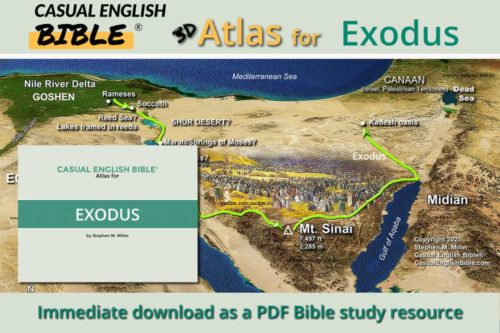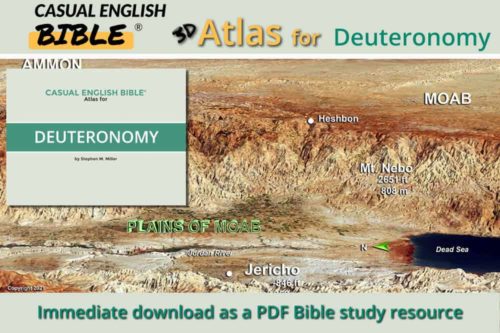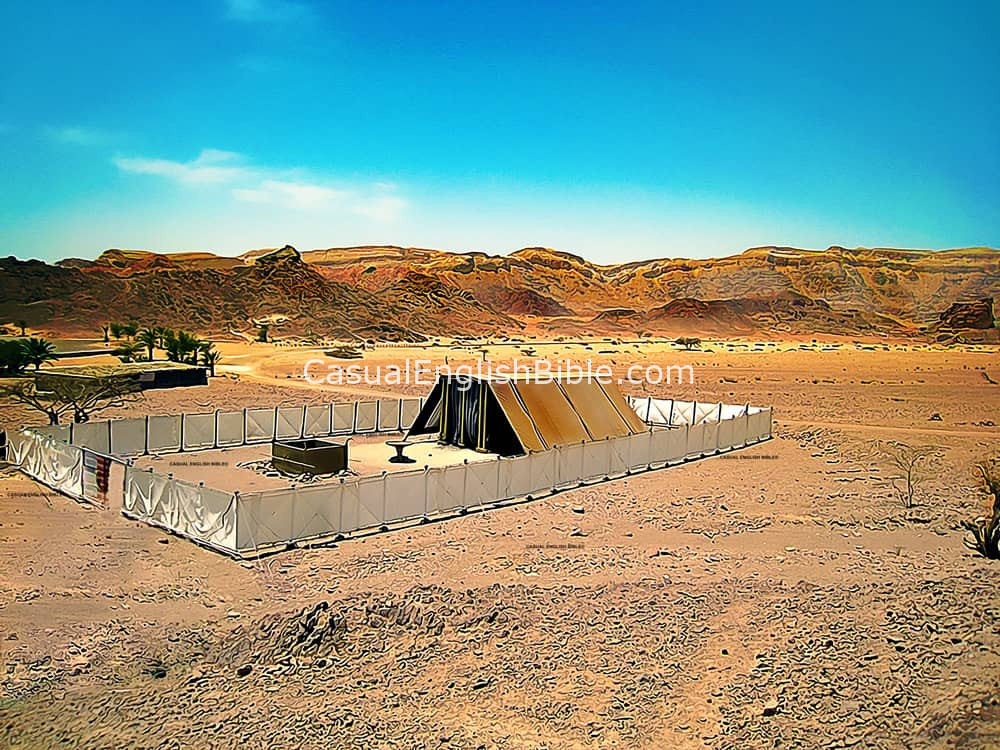Exodus 40
Moses assembles the tent worship center
Setting up the worship center
1The LORD told Moses, 2“I want you to set up the tent worship center on the first day of the new year. [1] 3Put the box [2] holding the Ten Commandments in the tent, in a separate room shielded behind a curtain. 4Then bring in the table and set up everything that goes with it. Set up the lampstand, with the lamps mounted on it.5Next, bring in the gold altar for burning incense. Set it in front of the box that holds the Ten Commandments. Install the curtained doorway into the tent worship center. 6Put the altar that you’ll use to burn animal sacrifices just outside the entrance into the tent. 7Put the wash basin between the altar and the tent. 8Next, set up the curtain wall that will surround the tent and will create a courtyard in front of it. Also hang the curtains for the entrance into the courtyard.
Moses dedicates worship center, priests
9Then take the sacred olive oil and anoint the tent worship center and everything in it. Declare it as sacred and reserved for the LORD, devoted exclusively for service to him—and for that reason, holy. [3]10I want you to anoint the altar you’ll use to burn sacrificed animals. Anoint everything associated with the altar, including the utensils. This will reserve the altar for sacred use only, as holy. 11Then anoint the wash basin and its stand, reserving it for use in my service only. 12Next, I want you to escort Aaron and his sons to the tent entrance. There, wash them.
13Dress Aaron in the sacred clothes. Then anoint him and dedicate him to my service, as a priest under my direction. 14Dress Aaron’s sons in their tunics. 15Anoint them, as you did their father, to serve as my priests. Your act of anointing them will immediately authorize them to begin serving as my priests. They are the beginning of a line of priests that will extend for generations to come.” 16Moses did what the LORD said.
Moses sets up the tent worship center
17Moses had the tent worship center erected on New Year’s Day—Day One of their second year on the move out from Egypt. 18So, Moses set up the tent worship center. He laid out the bases and then assembled the frames and inserted them into the bases. He put the crossbars in place and set up the support posts. 19He draped the embroidered tent fabric over the frames—the curtain that formed the interior walls of the tent. Then he added the extra layers of protection, as the LORD said he should do.20Moses then took the two stone tablets inscribed with the Ten Commandments [4] and placed them inside the Box of the Law. 21Moses brought the box into the tent and set up the curtain that screened it off into a separate room, [5] as the LORD instructed.
22He set the table in the tent, on the north side. That’s just outside the curtained room containing the sacred box that held the Ten Commandments etched in stone. 23He set the Bread of God’s Presence [6] on the table, as the LORD told him to do. 24He set the lampstand on the south side of the tent, opposite the table. 25The LORD watched Moses light the lamps, just as the LORD told him to do.
26Next, Moses brought into the tent the gold altar, which priests would use to burn incense. He put it in front of the curtain entrance into the Most Sacred Room. 27Then he burned aromatic incense on it, as the LORD told him to do. 28Moses then hung the curtain at the entrance into the tent.
Moses burns the first sacrifice
29He set the altar for burning sacrificed animals in front of the entrance into the tent. Then he burned the first sacrifice of an animal and of grain, as the LORD instructed. 30He put the wash basin between the tent and the altar. And he filled the basin with water. 31Moses and Aaron along with Aaron’s sons washed their hands and feet there.32Whenever they got ready to approach the altar or to go inside the tent worship center, they washed. That’s what the LORD told Moses they should do. 33Moses assembled the courtyard walls, which were made of curtains, and which surrounded the tent worship center. He also hung the curtain at the entrance into the courtyard. That finished the job. Moses had set up the tent worship center.
God arrives in a cloud
34A cloud [7]appeared above the tent worship center. Inside, the glorious presence [8] of the LORD filled the tent. 35Moses couldn’t go into the tent because the cloud had nested onto it and the presence of the LORD had filled it. [9]36Whenever the cloud lifted, the people of Israel broke camp and continued their journey. 37When the cloud stayed where it was, over the pitched tent, the people stayed there with it, in the camp. 38Throughout Israel’s journey, whenever the people set up camp, the cloud of the LORD hovered above the tent. At night, there was a fiery glow inside the cloud. [10] The people of Israel saw it.
Footnotes
This was sometime in March or April. The Israelites followed a lunar calendar, based on the cycles of the moon. The writer earlier called the first month of the new year Abib (Exodus 34:18), an older name of the month that became known as Nisan (March-April). In fact, the month is called Nisan in Exodus 12:2, where the feast of Passover is first discussed. Following a lunar calendar, every month starts at the first tiny crescent after the new moon. A new moon is when the moon is hidden behind earth’s shadow for one day. The sun, moon, and earth are aligned, with earth in the middle. Nisan is when Jews celebrate one of their most revered holidays: Passover. The month falls around Eastertime. Jesus went to Jerusalem to observe Passover when he was arrested and crucified.
Better known as the Ark of the Covenant, Israel’s most sacred relic, kept in the Most Sacred Room in the tent worship center.
Worship utensils such as lampstands were considered holy because they were reserved for sacred use, devoted to God. People, too, were considered holy when they devoted themselves to God.
More literally “the Testimony” or “the Agreement.” Moses put the two stones in a gold-covered box often called the Ark of the Covenant, which essentially means the Box of the Contract. It was a contract or agreement between God and Israel. Israel agreed to follow God’s laws and God promised to protect them and to take them to their new home.
The box containing the Ten Commandments was isolated in the Most Sacred Room, sometimes known as the Holy of Holies. Only Moses and the high priest, Aaron, could go in there. Aaron’s sons, the remaining priests, were limited to the tent’s main room, the Sacred Room.
The table was for displaying consecrated bread, known as the Bread of the Presence or Shewbread. Every Sabbath day, priests put 12 fresh loaves of bread on the table. A week later, priests ate those loaves and replaced them with another dozen loaves of bread (Leviticus 24:5-9).
The Hebrew word, anan, can mean “cloud,” “smoke,” or “mist.” It’s associated with God’s presence; it appears when God arrives. When the people of Israel were on the move, they followed what is most often translated as a pillar of cloud. But that “cloud,” too, can also mean smoke, whether natural or supernatural. Since this is a pillar of fire at night, it might seem logical to presume it’s a pillar of smoke and fire during the day.
The Hebrew word for “glorious presence” is kabod, often translated as “glory.” It refers to God. It’s a word that can also mean: splendor, honor, dignity, wealth.
It’s unclear if Moses was afraid to enter the tent or if he felt that God needed a moment in this new place or if he felt that with God filling the tent, there wasn’t even standing room available. We could keep guessing. But Leviticus is next.
This cloud of smoke and fire sounds a like part of the same occurrence described in Exodus 13:21, “The LORD traveled in front of them, in a rising column of smoke by day and a column of fire at night, which lit their way. That allowed them to travel day or night.”
Discussion Questions
- Sorry, there are currently no questions for this chapter.







